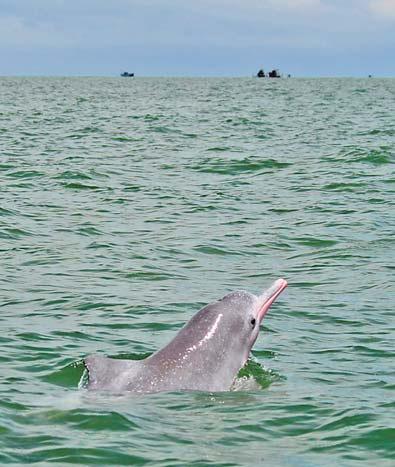Plight of dolphins major issue amid city expansion
As the dolphins swam by and frolicked among the waves, cheers erupted from three nearby motorboats.
 |
|
A dolphin frolics in the waters of Sanniang Bay, Qinzhou in the Guangxi Zhuang autonomous region. |
The cameras flashed and clicked as the majestic creatures dived deeper in the shallows of Qinzhou's Sanniang Bay in the Guangxi Zhuang autonomous region, before darting, almost teasingly, away.
Although called humpback dolphins and categorized in marine biological terms as being part of the Sousa genus, those in Sanniang Bay are distinctive sub-species called Sousa chinensis, or the Chinese White Dolphin.
Usually pinkish white, light or dark gray in color, the dolphins have conspicuous humps and low, slightly curved fins.
The marine mammal, whose cousins live along the Chinese coast in the Pearl River Delta, Leizhou Peninsula in Guangdong province, Xiamen harbor in Fujian province and Taiwan island, is unique to China and listed in the State's top wildlife protection category.
"It's not often you see so many of them gather together and get so intimate with each other," said Chen Mei, a doctoral student at Peking University, who is studying the impact of environmental changes on the natural habitat of the dolphin.
While filming the dolphins playing and making notes, she looked up and frowned at the sight of several large fishing boats not too far away.
"By local law, ships are not supposed to get so close to the area where the Chinese white dolphins live," said fisherman Huang Xiaode, 30, as he steered the motorboat towards a collection of bubbles made by the sea mammals. "We've seen a dolphin with a deep cut a few inches down his neck. A fishing boat cut him a few years ago."
Still, over the years the gentle waters of Sanniang Bay have remained a relatively quiet sanctuary for the Chinese white dolphin. They have been least affected by economic development.
 0
0 







Go to Forum >>0 Comments